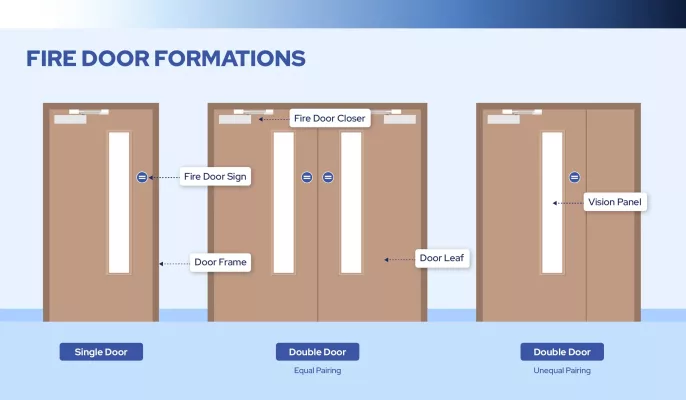Fire Doors Research Field: Analysis of Fire Resistance Performance of Fire Doors and Fire Shutters “Fire doors” Authors: Liu Zhipeng, Zhang Yulin, Zhang Zheng, Li Bo,(1. Guangdong Product Quality Supervision and Inspection Research Institute; 2. Guangdong Provincial Fire Brigade) Abstract: The fire resistance performance ofBlaze-rated door and fire shutters is a critical indicator for evaluating […]
Tag Archives: Analysis of Fire Resistance Performance of Fire Doors and Fire Shutters
Analysis of Fire Resistance Performance in Double Swing Fire Doors Based on Thermo-Mechanical Deformation and Gap Size
Presented by YK Fire Door Manufacturer — China’s Leading Fire Door Supplier
As the demand for fire safety in modern construction continues to intensify, understanding the thermo-mechanical behavior of double swing fire doors becomes essential. At YK Door Industry, we specialize in designing, testing, and manufacturing a comprehensive range of fire rated door systems, including steel commercial doors, wooden fire resistant doors, and 90 minute fire rated wood doors. This technical analysis explores how thermal gradients and structural gaps influence the performance and integrity of fire doors, contributing to regulatory compliance and long-term safety in buildings.
Fire doors function as critical components in passive fire protection, dividing compartments and slowing the spread of fire, smoke, and toxic gases. Unlike ordinary commercial doors, fire rated wood doors and steel fire doors are required to maintain structural stability under extreme conditions, as defined in ISO 834-1 and ISO 3008-1. These doors must withstand thermal stress, limit deformation, and prevent hot gas leakage through regulated exposure periods.
In real fire scenarios, temperature gradients between the fire-exposed and protected surfaces can lead to significant bending deformation. This structural warping becomes especially concerning in double-leaf fire doors, where excessive deflection can result in separation at the meeting stile or compromised latch mechanisms. These issues can render a fire exit door ineffective, creating hazardous conditions during evacuation.
Building on these concerns, the research introduces a simplified thermo-mechanical model to simulate the behavior of fire rated steel doors under rising temperatures. The model is based on beam deflection theory and integrates both material properties and thermal distribution. Moreover, a novel gap size deformation criterion is presented, offering practical insights for real-world applications such as fire door garage installations or fire doors in high-traffic commercial buildings.
2.1 Thermo-Mechanical Modeling of Fire Door Deformation
Predicting Thermal Deflection in Double Swing Fire Doors
To evaluate the bending behavior of double swing fire doors under thermal stress, a simplified thermo-mechanical model is proposed, reflecting the deflection compatibility often observed in complex structural systems. As illustrated in Figure 2, the deformation pattern resulting from a thermal gradient closely mirrors that of a simply supported beam subjected to a uniformly distributed load PfireP_{\text{fire}}. This analogy provides a practical basis for applying classical structural mechanics to assess door deflection caused by uneven heating between the exposed and protected surfaces. Such modeling techniques are also valuable when assessing the performance of fire doors and fire shutters, where differential thermal loads and structural deflection play a critical role in fire containment effectiveness.
Fire doors and fire shutters serve as essential barriers in building safety, designed to contain and slow the spread of fire and smoke within a structure. Unlike regular doors, fire doors are constructed with specialized materials and sealing systems that can withstand high temperatures for extended periods, helping to protect occupants and property. Fire shutters, often installed in larger openings such as warehouses or commercial storefronts, operate by automatically lowering to block fire and smoke passage when alarms trigger. Both products must meet stringent regulatory standards and undergo rigorous testing to ensure their performance under real fire conditions. Proper installation and regular maintenance are equally critical, as even the highest quality fire doors and fire shutters can fail if gaps are too large or mechanisms are compromised. In practice, collaboration between manufacturers, installers, and building managers is key to maximizing fire safety and compliance.
The deflection of such a system is governed by:
umax=5PfireW4384EIu_{\text{max}} = \frac{5P_{\text{fire}}W^4}{384EI}
Where:
umaxu_{\text{max}}: Maximum central deflection
EE: Elastic modulus of steel
II: Moment of inertia of the door section
WW: Width of the door leaf
The thermal load PfireP_{\text{fire}}, induced by the temperature differential across the door surfaces, is given by:
Pfire=48αEI(Thot−Tcold)5tW2P_{\text{fire}} = \frac{48\alpha EI(T_{\text{hot}} – T_{\text{cold}})}{5tW^2}
This model becomes especially relevant in evaluating fire rated steel doors, where high thermal exposure can lead to large-scale deformation. The door’s overall stiffness is affected by both its width and height. The stiffness contributions in each dimension are calculated using:
KW=384EI5W4,KL=384EI10L3K_W = \frac{384EI}{5W^4} \quad , \quad K_L = \frac{384EI}{10L^3}
Accordingly, the total stiffness for a double-leaf fire door is:
Kdoor=KW+KL=384EI5(1W4+12L4)K_{\text{door}} = K_W + K_L = \frac{384EI}{5}\left( \frac{1}{W^4} + \frac{1}{2L^4} \right)
And the maximum deformation becomes:
umax=PfireKdooru_{\text{max}} = \frac{P_{\text{fire}}}{K_{\text{door}}}
This methodology is critical for fire door manufacturers aiming to optimize structural reliability while complying with international fire door testing standards such as ISO 834-1 and ISO 3008-1.
To capture the influence of material degradation under fire exposure, the elastic modulus was treated as a temperature-dependent parameter. Based on Poh’s empirical reduction formula, the modulus at elevated temperature Es,TE_{s,T} is given as:
Es,TEs=C1Thot+C21+∣C3Thot+C4∣0.2+C5\frac{E_s,T}{E_s} = \frac{C_1 T_{\text{hot}} + C_2}{1 + |C_3 T_{\text{hot}} + C_4|^{0.2}} + C_5
Where the constants C1C_1 to C5C_5 are calibrated values derived from experimental steel behavior at high temperatures. This thermal degradation model ensures a realistic prediction of bending deformation in fire rated doors under extreme heat.
Integrating temperature effects, the modified deformation equation becomes:
umax=Pfire⋅EsEs,T⋅Kdooru_{\text{max}} = \frac{P_{\text{fire}} \cdot E_s}{E_{s,T} \cdot K_{\text{door}}}
For commercial door suppliers and China fire door manufacturers like YK, this approach supports the development of products that not only meet code but also deliver measurable resilience under real-world fire conditions.
2.2 Geometric Modeling: Establishing Deformation Limits
Gap-Based Failure Criteria in Double Swing Fire Doors
As defined in ISO 3008-1, fire doors must prevent flame penetration to the unexposed side for more than 10 seconds, and must not allow standard test gauges to pass through. In single-leaf fire doors, the thermo-deformation model sufficiently captures performance since only the door leaf deforms. However, double-leaf fire doors introduce additional complexity—both leaves deform simultaneously, and the risk of disengagement at the meeting stile becomes critical.
In this study, a failure criterion is established based on critical deformation—the point at which the door leaves separate due to excessive thermal expansion, resulting in fire resistance loss.
As shown in Figure 4, double swing fire doors deform symmetrically like a single simply supported beam. At a specific point, thermal expansion causes the leaf edges to drift apart. This moment defines the threshold for fire resistance failure. Figure 5 demonstrates two scenarios:
Without a gap: the maximum critical deformation ucru_{cr} is calculated using Pythagorean geometry:
ucr2=14W2−(W−αΔTW)2u_{cr}^2 = \frac{1}{4}W^2 – \left(W – \alpha \Delta T W\right)^2
With an initial gap: the effective deformation is reduced since part of the thermal expansion closes the gap:
ucr_g2=14W2−(W−αΔTW−gap)2u_{cr\_g}^2 = \frac{1}{4}W^2 – \left(W – \alpha \Delta T W – \text{gap}\right)^2
This criterion is essential for fire door suppliers when evaluating the tolerable gap sizes in pre-installation phases. Even minimal deviations can significantly affect fire resistance, particularly in high-performance fire rated steel doors or large commercial openings.
2.3 Fire Resistance Testing and Validation
Performance Assessment of Insulated and Non-Insulated Fire Doors
To validate the above predictive model, a fire resistance test was carried out on two representative door types—insulated and non-insulated—both commonly used in the Korean construction market. As summarized in Table 1, both test specimens were previously certified under KS F 2268-1 with a 60-minute integrity rating (E60).
The insulated door featured a mineral wool core.
The non-insulated door used a paper honeycomb core.
Both had a designed meeting-stile gap size of 5 mm, a common tolerance in commercial fire doors.
The external cladding for both models consisted of 0.8 mm galvanized steel, with a thermal expansion coefficient of 1.15×10−51.15 \times 10^{-5}.
As shown in Figure 6, the testing procedure involved installing each specimen within a sealed frame and exposing them to fire in a furnace chamber. The temperature distribution followed the ISO standard time-temperature curve, and monitoring was performed using thermocouples (on the fire-exposed side) and thermal imaging (on the unexposed surface). Deformation at the center of the door was measured every 5 minutes using a precision laser distance meter.
This real-world fire testing scenario allowed researchers to correlate theoretical predictions from Equation (10) with actual behavior under standard conditions, helping fire door manufacturers refine product design and ensure code compliance.
3. Fire Resistance Performance of Insulated and Non-Insulated Fire Doors
3.1. Behavior of Insulated Fire Door Specimens
The fire resistance behavior of insulated fire doors was evaluated through bidirectional testing, simulating fire exposure from both sides. Figure 7 captures the progression of thermal impact on the unexposed face at various intervals. Since commercial fire doors are required to resist fire spread irrespective of fire origin, testing under both pulling and pushing force conditions is essential.
For the first 10 minutes, no significant visual change—such as discoloration or deformation—was detected. However, at the 20-minute mark, internal reinforcement began to transmit heat. By 30 minutes, the joint between the double leaves showed visible discoloration, indicating localized heat penetration. From 50 minutes onward, structural integrity degraded on the side under tension, and by 57 minutes, a visible gap had formed—marking the failure of the door’s thermal integrity.
In Figure 8, centerline deformation of the insulated fire door was plotted against time using laser measurements. The empirical data closely aligned with theoretical predictions from a thermal deformation model, with a Pearson correlation coefficient of 0.97. Minor discrepancies observed at 10–15 minutes are likely due to the delayed softening of vertical reinforcement, which initially retained its modulus of elasticity but lost structural effectiveness beyond 20 minutes. The red line in Figure 8 represents the deformation limit associated with a 5 mm allowable gap. Once the deformation crossed this threshold after 25 minutes, the door’s ability to resist opening was compromised, ultimately resulting in gap formation at 57 minutes.
3.2. Behavior of Non-Insulated Fire Door Specimens
The non-insulated fire door specimens exhibited a different deformation profile. As shown in Figure 9, surface discoloration became apparent as early as 20 minutes, yet the door maintained closure and resisted flame penetration for the full 60-minute duration. Thermal imaging results (Figure 10) revealed a distinct surface temperature evolution compared to the insulated type.
Figure 11 illustrates that the measured deformation of the non-insulated specimen never exceeded the 5 mm critical gap, ensuring compliance with fire protection thresholds throughout the test. Interestingly, while predicted values did surpass this limit, actual measurements remained below it, confirming that no structural breach occurred. The overestimation in model predictions during the final test phase (50–60 minutes) is attributed to rising surface temperatures detected by the thermal camera—affected by IR limitations not reflected in the ISO 834-1 standard furnace curve.
4. Discussion: Fire Door Gaps and Their Impact on Performance
Maintaining precise clearances is vital for a fire-rated door’s effectiveness. Excessive gaps not only compromise smoke and flame containment but may also result in premature failure due to thermal deformation. Installation inconsistencies—especially from small-scale welding operations—can lead to variable clearances. Additionally, wear over time further increases the gap; empirical studies have found that after five years, the average clearance can reach 12.25 mm, far exceeding fire safety limits.
According to NFPA 80, the allowable clearance for hollow metal fire doors is 3.18 mm ± 1.59 mm. The current study applied a validated deformation model to simulate thermal behavior of double-swing fire doors and assessed the implications of varying gap tolerances. Figure 12 overlays model predictions and real-world measurements for both insulated and non-insulated fire door systems under 3 mm and 12.5 mm gap scenarios. While deformation exceeded acceptable thresholds at 12.5 mm, all values remained within bounds at 3 mm, underscoring its suitability as a maximum clearance for reliable fire performance.
These findings demonstrate that for a 2400 mm × 2400 mm × 50 mm insulated fire door, a 3 mm gap is the optimal design target to ensure thermal containment and structural integrity. In the case of non-insulated models, the experimental data indicates that a 5 mm gap may still be acceptable in practice; however, predictive modeling—especially when applied to high-performance fire doors and fire shutters—continues to support the 3 mm specification as the preferred safety margin. This tighter tolerance enhances the door’s ability to resist flame penetration and minimize heat transfer during fire exposure.
5. Conclusion and Engineering Recommendations
This investigation proposed and validated a mathematical model describing the thermal deformation of double-swing fire doors under fire exposure. The model achieved high predictive accuracy, as evidenced by Pearson correlation coefficients ranging from 0.97 to 0.99 when compared against experimental data.
A novel deformation criterion—derived geometrically—was introduced as a performance benchmark, enabling the quantification of acceptable structural changes under fire load. Based on this analysis, the study concludes that gap tolerances of 3 mm (and in some cases, as low as 2 mm) are necessary to preserve fire integrity in both insulated and non-insulated fire doors. While the NFPA 80 standard of 3.18 mm ± 1.59 mm generally ensures compliance, doors of larger sizes or specific configurations may require even stricter tolerances.
Figure 13 maps out optimal maximum clearances for various fire door dimensions. For common insulated door sizes such as 2000 mm × 2500 mm and 2500 mm × 2500 mm, the data recommends maximum clearances of 2 mm and 3 mm, respectively. For larger non-insulated doors—such as 2500 mm × 3000 mm or 3000 mm × 3000 mm—the suggested gaps are similarly 2–3 mm. These insights highlight the limitations of applying a universal clearance standard across all fire door sizes.
In future work, YK Fire Door Manufacturer—China’s leading fire door supplier—plans to extend the model to address glazed double-swing fire doors. By incorporating transparent panel behavior under thermal load, we aim to refine performance-based fire door specifications and contribute to more robust fire protection standards globally.
Experimental testing validated this model using both insulated and non-insulated door specimens, reflecting real market conditions for products like wooden fire doors and fire rated door frames. The results confirm that as the gap between double doors increases, the likelihood of structural failure during fire testing also rises. For manufacturers like YK, this reinforces the importance of precise engineering and strict quality controls during both fabrication and installation — a philosophy that underpins our position as a top China fire door manufacturer and fire door supplier.


